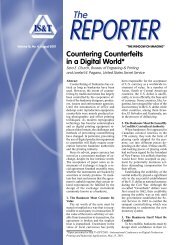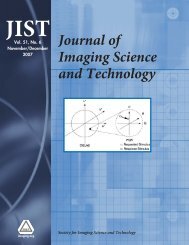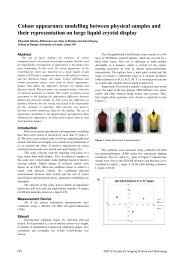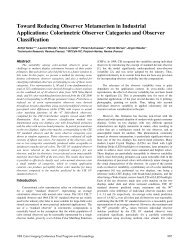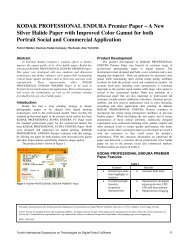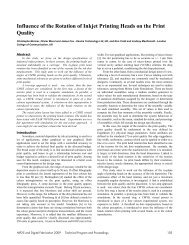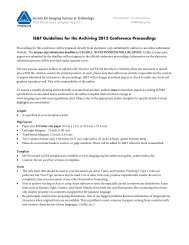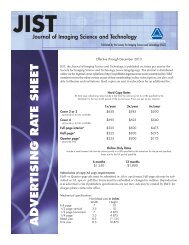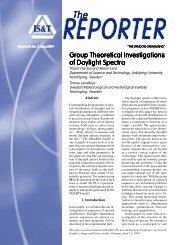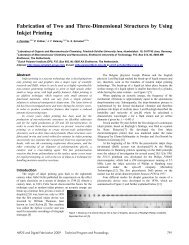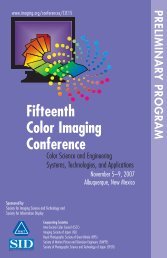JIST - Society for Imaging Science and Technology
JIST - Society for Imaging Science and Technology
JIST - Society for Imaging Science and Technology
Create successful ePaper yourself
Turn your PDF publications into a flip-book with our unique Google optimized e-Paper software.
Journal of <strong>Imaging</strong> <strong>Science</strong> <strong>and</strong> <strong>Technology</strong>® 51(5): 402–406, 2007.<br />
© <strong>Society</strong> <strong>for</strong> <strong>Imaging</strong> <strong>Science</strong> <strong>and</strong> <strong>Technology</strong> 2007<br />
Human Perception of Contour in Halftoned Density Step<br />
Image<br />
Phichit Kajondecha, Hongmei Cheng <strong>and</strong> Yasushi Hoshino<br />
Department of Systems Engineering, Nippon Institute of <strong>Technology</strong>, Miyashiro, Saitama, 354-8501, Japan<br />
E-mail: s3054602@sstu.nit.ac.jp<br />
Abstract. Contour is an important element of an image, usually<br />
expressed by the difference in density between two areas of an<br />
image. Objects are usually recognized from observation of their contours.<br />
In some cases, emergence of a false contour is a problem in<br />
image coding <strong>and</strong> decoding. Halftoning is an essential image process<br />
<strong>for</strong> digital printing of continuous tone. Contour perception is<br />
studied experimentally under various halftoning conditions, observation<br />
distances, <strong>and</strong> illumination conditions. The results show that in<br />
the human visual system, contour perception becomes easier with a<br />
decreasing stimulus of dots, which serve as the component of a<br />
halftone image. © 2007 <strong>Society</strong> <strong>for</strong> <strong>Imaging</strong> <strong>Science</strong> <strong>and</strong><br />
<strong>Technology</strong>.<br />
DOI: 10.2352/J.<strong>Imaging</strong>Sci.Technol.200751:5402<br />
INTRODUCTION<br />
In image processing, contours or boundaries in an image are<br />
important factors because our perception <strong>and</strong> recognition of<br />
an object depend on contour. In a sense, there<strong>for</strong>e, our eyes<br />
can be said to search <strong>for</strong> contour in an image. 1 Contour is<br />
the boundary between two areas of different density, color,<br />
or texture. If the dots are sufficiently small, the eye cannot<br />
detect the dot pattern 2 <strong>and</strong> we can recognize contour. In<br />
order to achieve high-quality image printing, the contour<br />
expression characteristics of an image are considered important.<br />
One way to underst<strong>and</strong> <strong>and</strong> evaluate image quality is<br />
use of the human visual system (HVS). 3–5<br />
Digital halftoning is essential <strong>for</strong> processing in digital<br />
printing <strong>and</strong> can be achieved by various methods. A conventional<br />
halftone is a fundamental method that has a wide<br />
application in printing. Digital halftoning has been evaluated<br />
from various viewpoints, but we have not yet gained a sufficient<br />
underst<strong>and</strong>ing of the relationship between the ease of<br />
perceiving contour, which is one of most fundamental elements<br />
of an image, <strong>and</strong> half-toning methods.<br />
In this study, images with contours of two different density<br />
values are processed to halftoned images of various halftone<br />
cycles <strong>and</strong> halftone angles of 0° <strong>and</strong> 45°. These<br />
halftoned images are observed under several conditions of<br />
illumination <strong>and</strong> observation distance. With respect to halftone<br />
frequency, images of relatively large cycles are prepared<br />
<strong>for</strong> accurately expressing the density of the image. If the<br />
observation is conducted at long distances, the condition of<br />
view angle from the eye is the same as that of a small cycle.<br />
The perception of contour is examined under various conditions,<br />
<strong>and</strong> the dependence of perception ratio on the difference<br />
in density is obtained. As the stimuli of the halftone<br />
cycle decrease relative to the density difference between regions,<br />
the contour is perceived more easily.<br />
EXPERIMENTAL<br />
As shown in Figure 1, two types of images were produced,<br />
each of which differed with respect to the direction of the<br />
contour line: (a) Images with perpendicular contour lines<br />
<strong>and</strong> (b) images with diagonal contour lines. The images were<br />
printed at a size of 10 cm10 cm with a resolution of<br />
300 dpi. The image printing conditions are shown in Table<br />
I, <strong>and</strong> as can be seen in the table, in some cases the density<br />
level of area A was fixed at 192 while the density level of area<br />
B was varied between 191 <strong>and</strong> 180. In other cases, the density<br />
level of area A was fixed at 64 while that of area B was<br />
varied between 63 <strong>and</strong> 52.<br />
Figure 2 illustrates the halftone dot arrangement, screen<br />
dot shape, <strong>and</strong> screen angle. The screen dot shape of the<br />
halftone is circular <strong>and</strong> produced at two screen angles (0°<br />
<strong>and</strong> 45°). As shown in Figure 3, the cycle of halftone dots<br />
was prepared in four levels: 1mm, 2mm, 3mm, <strong>and</strong><br />
4mm.<br />
The observation experiments are carried out as illustrated<br />
in Figure 4. The halftoned images were presented under<br />
three illumination conditions at four different observation<br />
distances. The perception ratios are obtained as the<br />
ratio of testees who perceived contour (responded “yes”)<br />
verses total testees. Testees who could not perceive contour<br />
responded “no.”<br />
RESULTS AND DISCUSSIONS<br />
The perception ratios obtained in the experimented conditions<br />
are plotted against the density difference between areas<br />
Received Feb. 2, 2007; accepted <strong>for</strong> publication May 7, 2007.<br />
1062-3701/2007/515/402/5/$20.00.<br />
Figure 1. Example density difference patterns: a perpendicular contour<br />
pattern <strong>and</strong> b diagonal contour pattern.<br />
402




